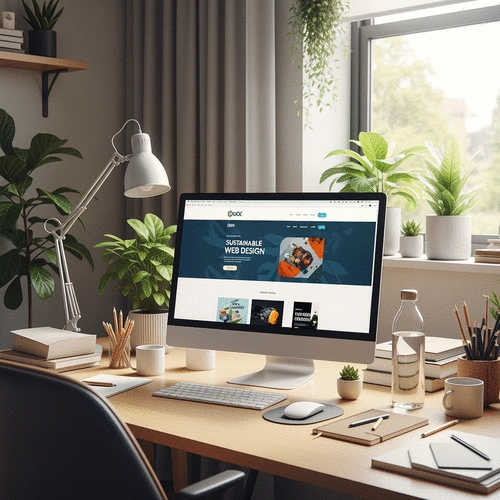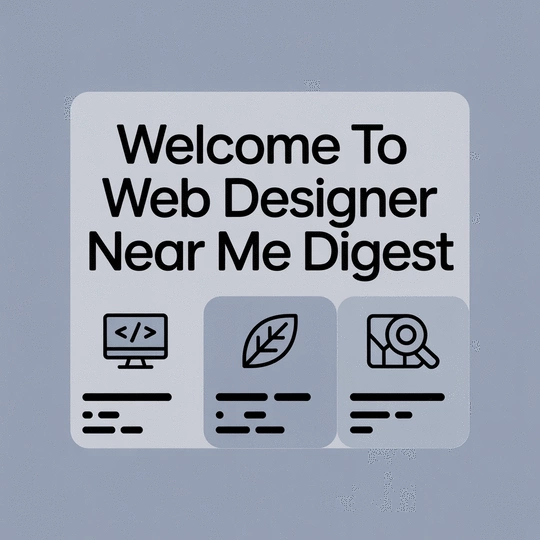As consumer awareness around sustainability grows, businesses must adapt or risk falling behind. What steps can your brand take to not only align with these values but also gain a competitive edge? Delve into the world of sustainable web design and discover its transformative potential for your business.
What You Will Learn
- Sustainable web design minimizes environmental impact while maximizing user engagement.
- Consumers increasingly prefer brands that demonstrate commitment to sustainability.
- Aligning web design strategies with the UN's Sustainable Development Goals can enhance brand credibility.
- Implementing sustainable practices can improve brand loyalty and attract eco-conscious customers.
- A structured checklist can streamline your transition to a more sustainable web design approach.
- Collaborating with experts can facilitate effective implementation of sustainable design practices.
The Pillars of Sustainable Web Design for Australian Businesses
This visual outlines the key components and benefits of sustainable web design, highlighting its alignment with global goals and competitive advantages for businesses.
Defining Sustainable Web Design
- ✓Energy Efficiency
- ✓Resource Conservation
- ✓Accessibility Focus
Competitive Edge Benefits
- ★Attract Eco-Conscious Customers
- ★Improve Brand Loyalty & Visibility
- ★Reduce Operational Costs
Aligning with UN SDGs
- ●Goal 12: Responsible Consumption
- ●Goal 13: Climate Action
- ●Goal 9: Innovation & Infrastructure
Key Steps to Transition
- •Green Hosting Choice
- •Optimize Images & Code
- •Connect with Experts
Understanding Sustainable Web Design and Its Importance for Australian Businesses
As a web designer passionate about creating not just visually appealing, but also sustainable websites, I see the pivotal role that sustainable web design plays in today's digital landscape. For Australian businesses, this concept isn't merely a trend; it represents a significant shift towards eco-friendly practices that can enhance both functionality and user experience. If you're looking for expert guidance, consider choosing a local web designer who specializes in sustainable practices.
At Web Designer Near Me Digest, I aim to provide insights that empower local businesses. Understanding sustainable web design involves recognizing its broader implications—not only for your brand but also for the environment. Let’s dive deeper into what sustainable web design means in the Australian context.
Defining Sustainable Web Design in the Context of Australia
Sustainable web design refers to the practice of creating websites that minimize environmental impact while maximizing user engagement. This encompasses a range of factors including energy efficiency, resource conservation, and accessibility. In Australia, where eco-conscious values are increasingly prioritized, adopting sustainable design principles is a way to align with the national ethos of caring for our environment.
- Energy Efficiency: Optimizing energy use through efficient coding and design choices.
- Resource Conservation: Utilizing sustainable materials and practices in web development.
- Accessibility: Ensuring all users, regardless of ability, can engage with your website seamlessly.
By focusing on these elements, Australian businesses can foster a more responsible digital presence that resonates with environmentally aware consumers.
The Growing Necessity of Digital Sustainability
Digital sustainability is no longer just an option; it’s becoming a necessity for businesses seeking to thrive in a competitive market. As consumers become more conscious of their ecological footprint, they are increasingly drawn to brands that align with their values. This means that businesses must take proactive steps towards implementing sustainable practices in their digital spaces. For more insights, explore eco-friendly web development practices in Australia.
- Consumer Expectations: More customers prefer brands committed to sustainability.
- Regulatory Pressures: Governments are imposing stricter regulations on digital environmental impact.
- Brand Reputation: A sustainable approach can enhance your reputation and attract loyal customers.
Embracing sustainable web design can thus be a powerful differentiator for businesses, allowing them to connect more deeply with their audience.
Aligning Sustainable Web Design with the Sustainable Development Goals (SDGs)
The United Nations' Sustainable Development Goals (SDGs) provide a framework that aligns perfectly with the principles of sustainable web design. By integrating these goals into your web design strategy, your business can contribute to a greater cause while enhancing your brand's credibility.
- Goal 12: Responsible Consumption and Production: Optimize resources used in web hosting and design.
- Goal 13: Climate Action: Reduce carbon footprints through efficient digital practices.
- Goal 9: Industry, Innovation, and Infrastructure: Innovate design processes to be more sustainable.
By aligning your web design efforts with the SDGs, you not only fulfill a corporate responsibility but also engage with stakeholders and customers who value sustainability. Together, we can create a digital landscape that not only looks good but also does good!
Pro Tip
To further enhance your website's sustainability, consider implementing lazy loading for images. This technique ensures that images are only loaded when they enter the viewport, reducing initial load time and energy consumption. By optimizing your site's performance, you'll not only improve user experience but also contribute to a greener digital environment.
Summarizing the Business Case for Sustainable Web Design
At Web Designer Near Me Digest, I’ve seen how prioritizing sustainability in web design can provide a significant competitive edge for Australian businesses. It's not just about aesthetics; it’s about creating an online presence that reflects your values while appealing to a growing market of eco-conscious consumers. This shift towards sustainability not only enhances your brand’s reputation but also positions your business as a leader in your industry.
As sustainability becomes a critical factor in consumer decision-making, businesses that embrace these practices will stand out. In our world where climate change is a pressing concern, customers are increasingly drawn to brands that take actionable steps towards sustainability. Have you noticed a shift in how consumers respond to eco-friendly initiatives? It's clear that sustainability isn’t just a trend—it’s a crucial part of business strategy!
The Competitive Edge of Prioritizing Sustainability in Web Design
Incorporating sustainable practices into your web design efforts can yield numerous benefits. Here are some key advantages that come with prioritizing sustainability:
- Attracting eco-conscious customers: More consumers are seeking brands that align with their values.
- Improving brand loyalty: Sustainable practices foster trust and repeat business.
- Enhancing your online visibility: Search engines often favor eco-friendly websites, boosting your SEO.
- Reducing operational costs: Sustainable design often leads to more efficient resource use.
By embracing sustainability, you not only create a positive impact on the environment but also enhance your business’s bottom line. Have you considered how these factors might influence your own business strategy? It's time to think about how you can leverage sustainability as a powerful tool.
Your Role: Advocating for Sustainable Practices in Digital Spaces
As a business owner, you can be a champion for sustainable web design by advocating for practices that benefit both the environment and your business. Start by educating your team about the importance of sustainability in design. Together, you can create a culture that values eco-friendly approaches and encourages innovation.
Additionally, sharing your sustainability journey with your audience can help build a strong connection. Consider creating blog posts or social media updates that highlight your efforts and achievements. People love to support businesses that are transparent about their practices! What story can you share with your audience about your sustainability journey? You might also find value in understanding sustainable web design and its carbon impact.
Taking Action: Steps to Transition to Sustainable Web Design
Creating a Sustainable Web Design Checklist for Your Business
Transitioning to sustainable web design doesn’t have to be overwhelming! A simple checklist can help you stay organized and focused. Here’s a quick list to get you started:
- Assess your current website’s carbon footprint.
- Choose a green hosting provider that utilizes renewable energy.
- Implement image compression techniques to improve load times.
- Focus on clean code and minimalist design.
- Optimize your website for better accessibility and user experience.
This checklist can serve as a roadmap for your transition, ensuring that you cover all essential aspects of sustainable web design. As you check off each item, you'll feel more accomplished and encouraged to continue down this path!
Connecting with Experts to Guide Your Transition
Sometimes, navigating the world of sustainable web design can feel a bit tricky. Connecting with experts in the field can provide valuable insights and guidance. Look for local consultants or agencies that specialize in sustainable design. They can help you:
- Identify areas for improvement on your website.
- Implement cutting-edge sustainable practices.
- Stay updated on the latest trends in eco-friendly design.
Having the right support can make all the difference in your journey towards sustainability. You don’t have to do it alone—experts are here to help!
Leveraging Digital Transformation to Enhance Sustainability
Finally, embrace the digital transformation that comes with adopting sustainable web design. This means taking advantage of new technologies and tools that can enhance your sustainability efforts. For instance, consider using:
- Responsive design techniques to improve accessibility for all users.
- Analytics tools to track your website’s performance and ecological footprint.
- Content management systems that prioritize efficiency and sustainability.
By leveraging these digital solutions, you can enhance your website’s performance while minimizing its environmental impact. Remember, every step you take towards sustainability counts—let’s make a difference together!
Frequently Asked Questions About Sustainable Web Design
What is sustainable web design?
Sustainable web design is the practice of creating websites that minimize environmental impact while maximizing user engagement. This includes factors like energy efficiency, resource conservation, and accessibility.
Why is digital sustainability important for Australian businesses?
Digital sustainability is crucial for Australian businesses because consumers increasingly prefer brands that align with eco-conscious values. It enhances brand reputation, attracts loyal customers, and helps businesses comply with growing regulatory pressures.
How does sustainable web design align with the UN's Sustainable Development Goals (SDGs)?
Sustainable web design aligns with SDGs like Responsible Consumption and Production (Goal 12) by optimizing resource use, Climate Action (Goal 13) by reducing carbon footprints, and Innovation and Infrastructure (Goal 9) by fostering sustainable design processes.
What are the competitive advantages of prioritizing sustainability in web design?
Prioritizing sustainability in web design helps businesses attract eco-conscious customers, improve brand loyalty, enhance online visibility through better SEO, and reduce operational costs through efficient resource use.
What are some actionable steps to transition to sustainable web design?
Key steps include assessing your website's carbon footprint, choosing a green hosting provider, implementing image compression, focusing on clean code and minimalist design, and optimizing for accessibility and user experience.
Recap of Key Points
Here is a quick recap of the important points discussed in the article:
- Energy Efficiency: Optimize your website's energy use through efficient coding and design choices.
- Resource Conservation: Utilize sustainable materials and practices in web development.
- Accessibility: Ensure all users can engage with your website seamlessly, regardless of ability.
- Consumer Expectations: Align your brand with eco-conscious values to attract more customers.
- Regulatory Pressures: Be aware of increasing government regulations on digital environmental impact.
- Brand Reputation: Enhancing your sustainability efforts can improve your brand's image and foster loyalty.
- Checklist for Transition: Assess your website’s carbon footprint and implement sustainable practices such as green hosting and image compression.








